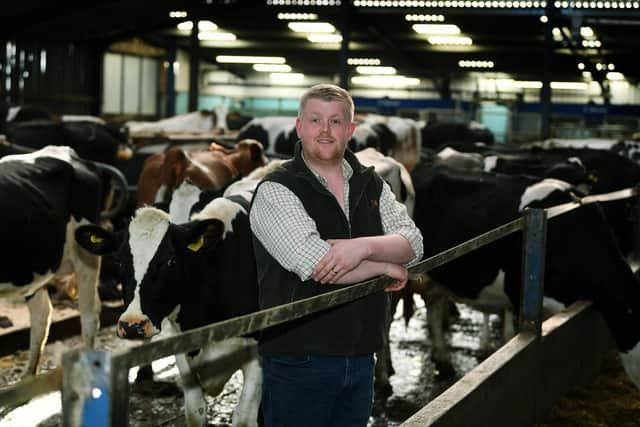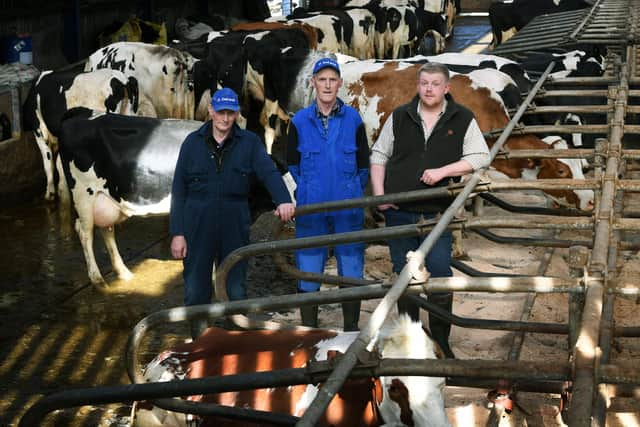Farm of the Week: Traditional Yorkshire dairymen who have switched to robotic milking
“I’m looking at growing our cow numbers,” says Ross Johnson who farms with his father Colin and uncle Robin at their 265-acre Low Whinholme Farm in Streetlam near Danby Wiske.
“What I’ve heard in recent meetings is it seems that a lot of really big herds, that some thought they needed to aspire to, are not necessarily the answer and some are realising if they just pull back on cow numbers things can be a bit easier.
Advertisement
Hide AdAdvertisement
Hide Ad“I think the 200-250 cow herds are going to become popular again, which is where we are heading. We have 150 cows at the moment. I’m looking at us getting to 170 and then to 200.


One of the methods Ross is going with is greater automation. The Johnsons moved away from conventional to robotic milking three years ago, installing three De Laval V310 robots.
“Up until the point of changing over to robots I was never one for standing in a parlour, so I was a bit stepped back from the cows. When a grant became available to go into robots it was an easy decision for me, as it was something I had always really wanted us to do.
“I can remember being at Askham Bryan College while studying and the teacher asking everybody where they saw themselves on their farms. Even then, at 17, I saw myself with robots and on a grazing system. I was always working towards it and now we have it our cows’ productivity and health just keeps getting better.
Advertisement
Hide AdAdvertisement
Hide AdRoss says he looked closely at each of the big robotic milking machine manufacturers before making the decision to go with De Laval.


“We had a new De Laval parlour after restocking following a contiguous cull of our stock during foot and mouth disease and we’ve always liked De Laval equipment. We looked at theirs and Lely and Fullwood, taking factory tours, watching the demonstrations and spent time looking at farms in Holland and the UK.
“It was their new 300 model that De Laval released while we were with them that sealed it. On these they run what is called the herd navigator system which is a kit that includes each cow’s PD (pregnancy diagnosis), progesterone (heat test) and health status. Having these has massively reduced our vet time. All of this is analysed every time they go to the robot, which is usually three and a half times a day. It’s a pretty impressive bit of kit, has saved us money and time and we’re more in control of the herd now.
“Each of our three robots are milking 50 cows at present, but with De Laval claiming they will do 70 we are able to continue to expand our numbers to my target of 200. Going up to 170 cows will mean we can add more cubicles to the existing shed. To get to 200 we will have to extend the building.
Advertisement
Hide AdAdvertisement
Hide AdRoss says that he aims to use new technology wherever he can, realising the benefits it can bring.
“I’m now focusing on robotics and automated systems to help not just milking the cows but also feeding the calves. We already run an automated slurry scraper system. We are currently looking at automatic calf feeders. I attended a Lely demonstration on them last month.
“Calf feeding by automation mixes the milk powder and water on demand, only when the calf wants to drink from it. Calves will feed from a teat in their stall and will benefit from a more natural feed of a little and often through the day.
Ross says the current crossbred herd of Montbeliarde cows, Friesian, British Friesian, Holstein and some Norwegian Red is swinging slightly towards the Montbeliardes.
Advertisement
Hide AdAdvertisement
Hide Ad“They’re a much more robust cow. They maybe don’t give the yield, but with them being crossbred off a Holstein they’re a nice cow with a bit more longevity. I’m certainly more swinging to the crossbreds than the purebreds. Our daily average per cow is around 30 litres.
“We’ve always grazed the whole herd and that has worked for us. I think cows like to be outside, they like a bit of sun. We normally have them in by around the second week in October and we like to try and get them out by late March, but as everyone knows the weather has been horrific. We’ve had water standing in fields all winter where I haven’t seen water standing for a long time. It’s been desperate.
“When we graze them we use an ABC system. They are in A paddock in morning; B paddock in afternoon; and C paddock is the shed with buffer feed. Our grazing platform is about 60 acres. Early in the season we strip graze them when grass growth is more prolific, using electronic fencing, and as the season goes on, when grass growth goes down, we split fields into paddocks.
Ross handles all of the AI work on the farm.
“We don’t run a bull at all. We use sexed semen on all the heifers and traditionally we were able to get our replacements from the heifers and we’d put conventional beef AI on the cows, but now everything is getting sexed semen as I’m making the best effort I can to expand the herd.
Advertisement
Hide AdAdvertisement
Hide Ad“If they haven’t held after three servings I put beef AI on them. We are at the beginning of running a programme with Genus for selected breeding.
“Our beef cattle are generally sold as stores at 10-11 months at Northallerton livestock market. We recently had a go at finishing a few, also selling through Northallerton.
The Johnsons’ milk contract is with Meadow Foods of Holme on Spalding Moor that Ross says he’s happy with.
“They’re not the top of the milk price league table but they’re not far off. What we like about Meadow is that they don’t have as many stipulations as other dairy companies.
Advertisement
Hide AdAdvertisement
Hide AdArable cropping is over 70 acres at Low Whinholme and is down to mainly cereals with Dawsum winter wheat, Orwell winter barley and maize.
“Barley is for the young stock and store cattle. We use the wheat as feed for the cows and depending on the year we often have a little bit of wheat for sale. The maize is for the cows. Our land is a mix of clay and loam.
“We are in with the new SFI, with the winter bird feed scheme, keeping stock off grass from October until March.
Sheep are the other livestock at Low Whinholme.
“My uncle has about 60 Bleu du Maine breeding ewes and shows them successfully. I’m not a sheep person. My uncle Robin’s flock is lambing at the moment.
Ross is married to Charlotte, a local farmer’s daughter whom he met while conducting agricultural contracting work. He and Charlotte have two young children Florence and Penelope.